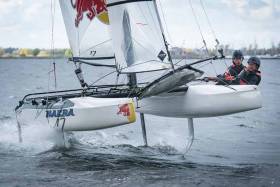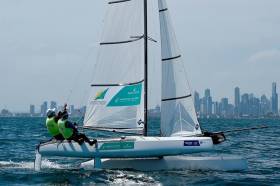Displaying items by tag: Nacra
Sailor Loses Fingers in Nacra Incident: World Sailing Publishes Report
World Sailing, the world governing body of the sport, has published an investigation report into the Nacra 17 incident involving Bora Gulari (USA). Download the report below.
The report, produced by a working party / investigation team led by Equipment Committee Chair Dina Kowalyshyn, provides a review into the incident, documenting the facts found with recommendations to reduce the likelihood of a recurrence.
On Wednesday 30 August 2017, Gulari sustained an injury during a training incident with teammate Helena Scutt as they were preparing for the Nacra 17 World Championship in La Grand Motte, France.
During a practice race, they were on starboard tack and fully foiling as they approached the offset mark at a speed estimated to be 17 knots. They pitchpoled (bow down resulting in a sudden stop) while rounding the windward offset mark and Gulari and Scutt travelled forward at a high-speed.
Gulari had the traveler control line wrapped around his hand and Gulari identified this as the cause of the incident.
 Injured Sailor with hand raised floating away from boat with crew close to boat
Injured Sailor with hand raised floating away from boat with crew close to boat
Video evidence, provided by Italian coach, Gabriele Bruni, shows the traveller control being held as the sailors are thrown forward and falling the leeward after they enter the water. However, there is no conclusive evidence to support the exact determination of the cause.
The document published provides a full report into the conditions the team were sailing in, the equipment they were using, medical records, full statements from Gulari and Scutt as well as a review into video shot on the water. Furthermore, the findings are outlined with the root cause of the injury sustained by Gulari coming from the pitchpole.
 Images of the sailors right hand after amputation. These photos are approximately three post injury
Images of the sailors right hand after amputation. These photos are approximately three post injury
From the report, six recommendations to avoid recurrence have been stated and include being aware of personal safety and the equipment used as well as ensuring there are appropriate event/local emergency procedures both on and off the water.
Safety in sailing was a major talking point at World Sailing's 2017 Annual Conference in Puerto Vallarta, Mexico.
As sailing evolves and develops, the risks in the sport are increasing and World Sailing are taking positive steps to protect the sailors and reduce the risks.
A safety framework was presented to the sports key stakeholders in Puerto Vallarta which includes the creation of a Safety Panel and an incident reporting web portal.
Member National Authorities and sailors will be encouraged to report all incidents. From there, the Safety Panel will assess each reported incident. Depending on the seriousness of the incident, they will make a decision on the next steps and whether to investigate further.
The end goal is to reduce the incidents in the sport and increase awareness of best practice. The next step is for World Sailing Committees to make their recommendations by mid-January to refine the framework.
World Sailing Confirms Roll Out Of Foiling Nacra 17
World Sailing has confirmed its support for the existing roll out plan to release the first batch of 45 Foiling Nacra 17’s on June 26. The European Championship, as previously stated in the released NoR will be a foiling event, and the World Championship in La Grande Motte, France, will also be raced in foiling Nacra 17’s. In addition, World Sailing with their partners in Aarhus, would like to announce that the Aarhus test event will also be conducted in Foiling Nacra 17’s.
As Afloat.ie reported in December, both the Nacra 17 Class Executive and the Board of World Sailing recently reviewed and debated all options on how to transition to the foiling Nacra 17. Both parties have confirmed their support for the initial plan, and this was made official in a letter to Nacra 17 class president, Marcus Spillane from the Board of World Sailing following their board meeting on April 25, 2017. With this confirmation World Sailing will review its plan for the Sailing World Series event in Japan for October 2017. It is probable that the Nacra 17 event will be cancelled for 2017 due to unavailability of sufficient foiling Nacra 17’s and lack of demand to race the event in C board Nacra 17’s. World Sailing will make an official announcement shortly.
The above news will mean disappointment for all teams not able to get their boats in the initial allocation or before the Worlds.
Since the initial distribution was announced in January, the manufacturing plans remain on time. In addition Nacra Sailing have increased their build capacity for the second half of 2017. The Class continues to investigate other options with Nacra Sailing to speed up the roll out of foiling equipment to as many teams as possible. Aside from equipment, Nacra is engaging with World Sailing on how best to minimize the medium-term impact of uneven equipment distribution to reduce its effect on future event entry particularly the qualifying for future Sailing World Cups.
This decision reflects the best course of action, despite their being no perfect solution. All parties are committed to ensuring that the equipment side of this Class is right for the 2020 Olympics.
Foiling Catamaran for Tokyo 2020 Olympic Games
Last month the World Sailing Council met in Barcelona, Spain, and confirmed the Nacra 17 will convert to foiling for the Tokyo 2020 Olympic Games, the only foiling class among the 10 Olympic sailing classes. It means Irish sailors with experience in cats or foils – or both – will be busy eyeing up the prospect of a first ever Irish Olympic catamaran campaign.
Most sailors agree the foiling move it’s a natural evolution for the sport and will be a fantastic addition for spectators. The Nacra sailors at Sailing World Cup Final Melbourne say once they’ve mastered the art of foiling it will create thrilling racing.
Not only will the Nacra 17 will be flying in Tokyo but at the same conference in Barcelona the foiling Nacra 15 was confirmed as official equipment for the Youth Olympic Games in Buenos Aires 2018, another prospect for buoyant Irish youth sailors to eye up.
On the announcement, Nacra 17 Rio 2016 silver medallist Lisa Darmanin (AUS) said, “I’m excited and a little scared. While Jase (Jason Waterhouse) is getting technical in Bermuda with the America’s Cup, my plan is to be in the gym becoming bullet proof. When we first start foiling the race course will be pretty scary at times, but come the Games it will be incredible.”
Darmanin’s helm Jason Waterhouse has the advantage of being part of the America’s Cup outfit SoftBank Team Japan who use foiling AC45s. “The foils on the Nacra will be different to the AC but actually learning about campaign management and development has been the biggest eye opener for me, and I’ll bring that experience to our next Olympic campaign.”
Helm John Gimson and crew Anna Burnet (GBR) anticipated the switch and have been sailing a foiling Nacra 20 in Bermuda, plus Gimson spent time on an AC45 during the last Cup cycle.
“We’re really excited about it,” Gimson said while rigging up for day two of their Sailing World Cup Final attempt. “I think it’s going to be quite a full on year getting used to foiling, but I think it’s good for the long term. It’s cool for the sailors to be the only foiling Olympic class and I think it’ll open up a new world for the spectators, and bring the Olympics into the 21st Century.”
“Foiling feels pretty cool, it’s pretty fast, twitchy, and I loved it,” Burnet said of her time on the Nacra 20.
Helm of the only team to take a win off Waterhouse and Darmanin in Melbourne so far and one of the few female Nacra 17 helms worldwide, Kiwi sailor Olivia Mackay, embraces the move to foiling. On the experience of flying above the water she says it’s really quiet and surreal, and hard to judge speed when the boat is lifted on its hydrofoils.
“I’m so excited for the class to go foiling,” Mackay said. “Forty boats foiling into the bottom gates is going to be interesting, and entertaining to watch.”
To retrofit the current generation of Nacra 17s would compromise performance according to Waterhouse, and the plan is for brand new boats to be manufactured. The talk about the yard is the new fleet will be ready in time for next year’s European Championship at Kiel, Germany, in July, but Waterhouse has some reservations that the new technology may price youth and developing nations out of the mixed gender class.
“For a kid it’s going to be harder to convince mum and dad or a federation to fund them in the Nacra, without a result to help them out. The positives are it’s a new challenge and development is part of the sport; it will be good for sailing’s image,” Waterhouse added.
After six of a 12-race schedule in Melbourne, the last event of the six-part World Series, Waterhouse/Darmanin (AUS) lead Mackay/Wilkinson (NZL) by seven points and the Great Britain team sits in third overall.
Not only will the Nacra 17 will be flying in Tokyo but at the same conference in Barcelona the foiling Nacra 15 was confirmed as official equipment for the Youth Olympic Games in Buenos Aires 2018.






























































